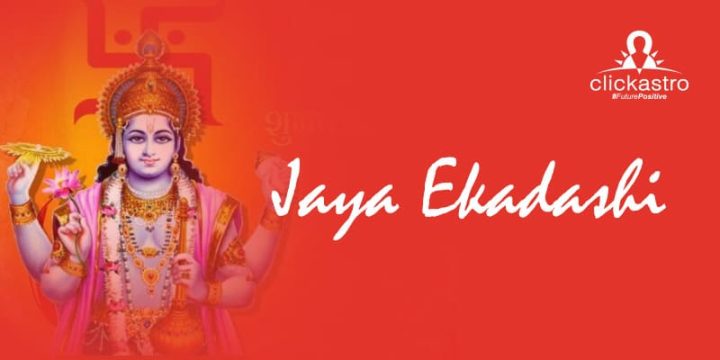Contents[hide]
Introduction
Jaya Ekadashi, an auspicious fasting observance, stands as a sacred event in the Hindu calendar. Occurring on the ‘Ekadashi’ tithi of the Shukla Paksha in the month of ‘Magh,’ it is a deeply revered day dedicated to the veneration of Lord Vishnu. Here, we embark on a journey to explore the different rituals, delve into their significance, and unravel the spiritual dimensions within the sanctity of Jaya Ekadashi.Jaya Ekadashi 2025 is on February 8, SaturdayDevotees immerse themselves into observance on this divine day by narrating ancient scriptures such as the ‘Padma Purana’ and ‘Bhavisyothara Purana’. These scriptures paint a vivid picture of spiritual purification and devotion. Through their detailed exploration, the essence of Jaya Ekadashi is illuminated, connecting the cultural ethos and religious diversity of this sacred occasion.
Significance of Jaya Ekadashi
The significance of Jaya Ekadashi is rooted in ancient Hindu scriptures, notably the ‘Padma Purana’ and ‘Bhavisyothara Purana.’ These sacred texts unveil the spiritual essence and historical context that elevate Jaya Ekadashi to a sacred status within the Hindu calendar. According to the scriptures, it was Lord Krishna who imparted the importance of this auspicious Ekadashi to King Yudhisthira. Jaya Ekadashi’s potency is emphasized by its transformative ability to absolve individuals of severe sins, including the grievous ‘Brahma Hatya.’ Observing vrat on this day is believed to purify the soul, offering devotees a pathway to redemption and spiritual liberation. The dual significance of Jaya Ekadashi, being dedicated to Lord Vishnu and aligning with the auspicious month of ‘Magh,’ deepens its importance. This convergence not only symbolizes the devotion to Lord Vishnu but also holds relevance for devotees of Lord Shiva. The spiritual significance of Jaya Ekadashi thus transcends boundaries, attracting followers from both sects who seek blessings and a means to transcend their worldly sins. In essence, Jaya Ekadashi stands as a sacred bridge between devotees and the divine, offering a transformative journey towards spiritual purity and enlightenment.Important Timings On Jaya Ekadashi 2025
- Sunrise – February 08, 2025 7:07 AM
- Sunset – February 08, 2025 6:14 PM
- Ekadashi Tithi Begins – February 07, 2025 9:26 PM
- Ekadashi Tithi Ends – February 08, 2025 8:16 PM
- Hari Vasara End Moment – February 09, 2025 2:03 AM
- Dwadashi End Moment – February 09, 2025 7:25 PM
- Parana Time – February 09, 7:06 AM – February 09, 9:20 AM
Rituals on Jaya Ekadashi
At the heart of Jaya Ekadashi lies the observance of the vrat or fast. This is an earnest spiritual commitment that starts from the ‘Dashami’ tithi and lasts till the sunrise of the ‘Dwadashi’ tithi. The fasting ritual is not merely a physical abstinence from food and drink but a holistic endeavor aimed at purifying both body and soul. Devotees adhere to a day-long refraining from sustenance, dedicating themselves to a heightened state of spiritual consciousness.
The essence of the vrat extends beyond dietary restrictions and encapsulates a state of mental discipline as well. Practitioners strive to keep their minds untainted by negative emotions such as anger, lust, or greed, fostering an environment of purity and devotion throughout the observance.
As the vrat culminates, devotees engage in a gesture of generosity by offering food to Brahmins on the Dwadashi tithi. This act symbolizes gratitude and abundance, marking the completion of the fasting period. The spiritual observance carries into the night with devotees participating in the night-long singing of bhajans, praising Lord Vishnu, and expressing their devotion.
Recognizing the diverse nature of the health of individuals, Jaya Ekadashi vrat can be observed in varying manners. Concessions are provided in the form of partial fasting, allowing the consumption of milk and fruits. This exception serves the needs of elderly individuals, pregnant women, and those grappling with serious ailments, ensuring that the spiritual connection is accessible to all. Even for those not observing fast, avoiding rice-based and grain-based foods, along with refraining from applying oil on the body, becomes a gesture of respect and alignment with the sanctity of Jaya Ekadashi. In this holistic approach, Jaya Ekadashi unfolds as a multifaceted ritual, offering a comprehensive path to spiritual purification and devotion.
Worship of Lord Vishnu
As the auspicious day of Jaya Ekadashi unfolds, devotees embark on a journey of worship dedicated to Lord Vishnu. At the break of dawn, they rise and purify themselves with a bath, also symbolizing spiritual cleansing and renewal. The sacred ritual unfolds with the placement of a small idol of Lord Vishnu in a sanctified space for worship.The devotional offering includes elements of deep significance: fragrant sandalwood paste, symbolic sesame seeds, fresh fruits symbolizing purity, glowing lamps representing enlightenment, and the cleansing essence of dhoop elevating the atmosphere. This ceremonial act is an expression of deep gratitude, reverence, and devotion towards Lord Vishnu. To achieve a deeper spiritual connection, devotees engage in the recitation of sacred texts such as ‘Vishnu Sahastranaam’ and ‘Narayan Stotra.’ These verses serve as a medium for devotees to express their devotion and seek the divine blessings of Lord Vishnu. Through this worship, Jaya Ekadashi becomes a transformative journey where devotees get in touch with Lord Vishnu, fostering in them a sense of spiritual fulfillment and divine connection that transcends everyday chores.
Jaya Ekadashi story
The tale of Jaya Ekadashi dates back to the vibrant music and dance festivals that were held in the court of Lord Indra during ancient times. Sages and deities gathered to revel in the festivities, which were led by the talented singer Mallyavan and the graceful dancer Palushyavati. However, the joyous occasion took an unexpected turn on one occasion when Palushyavati, captivated by Mallyavan’s appearance, attempted to seduce him. The celebratory atmosphere transformed into one of ominous misfortune as her actions distracted Mallyavan, causing him to forget the lyrics. Indra Dev, witnessing this disruption, became furious and, in his anger, expelled both Mallyavan and Palushyavati to Earth. Cursed and transformed into Pishachas, they found themselves in a harsh environment with freezing cold and no sustenance. Under a peepal tree, they endured their plight, reflecting on their misguided actions. Then, on one Jaya Ekadashi day, they observed a fast, seeking forgiveness from Lord Vishnu with deep devotion for their past sins.In response to their sincere penance, Lord Vishnu, moved by their remorse, restored Mallyavan and Palushyavati to their original forms and graciously sent them back to Indralok. The story of Jaya Ekadashi thus symbolizes the transformative power of repentance, fasting, and seeking forgiveness from the divine, offering a path to redemption for those who earnestly seek it.
Conclusion
Jaya Ekadashi transcends the confines of a traditional day of fasting. It is more of a spiritual odyssey of purification and devotion for Hindus. The strict adherence to rituals, deeply embedded in the fabric of ancient scriptures like the ‘Padma Purana’ and ‘Bhavisyothara Purana,’ imparts a timeless significance to this sacred occasion. Jaya Ekadashi becomes a sacred platform for seekers, offering diverse paths for spiritual fulfillment. Whether individuals embark on this day to seek salvation, absolve themselves of sins, or simply express unwavering devotion to Lord Vishnu, the multifaceted nature of this observance accommodates the spiritual aspirations of believers.As a beacon of spiritual significance in the Hindu calendar, Jaya Ekadashi stands as a testament to the enduring power of tradition, devotion, and the quest for spiritual purity. It beckons devotees to partake in a sacred journey, forging a deep connection with the divine, and finding solace in the age-old traditions that continue to illuminate the spiritual landscape.







